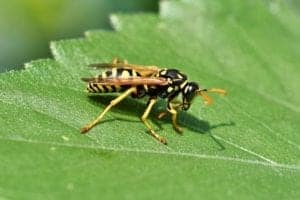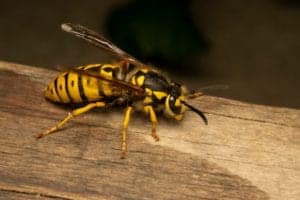Yellow Jackets vs. Paper Wasps: What’s the Difference?
Yellow Jackets vs. Paper Wasps:
What’s the Difference?
“We are family… I got all my Vespoidea’s with me!”
Both yellow jackets and paper wasps are part of the Vespoidea branch of the Hymenoptera family tree. Hymenoptera includes wasps, bees, and ants, while the Vespoidea branch of that tree narrows down to include wasps, yellow jackets and hornets. As such, these two flying pests are closely related and share a lot of similarities. However, to the trained eye, there is a host of differences between these sister species.
Physical Appearance
Both of these stingers possess yellow and black striped bodies with long, thin abdomens, however, paper wasps have more black on their bodies and a thinner, longer body. Notably, they also have an additional color to their overall hue – orange. This color is displayed on their legs and brightly on the tips of their antennae’s, distinguishing themselves from their other family members.


Observing these Vespoidea’s in flight can make discerning them from one another far easier due to their positions while in flight. Yellow jackets tuck their legs up against their body as they fly, making them arrow dynamic and quick. While also quick, paper wasps appear lazier in flight as they unceremoniously allow their long legs to dangle beneath them as they glide through the air.
Nests
Paper wasp nests are typically constructed under decks, or on the eaves of a home and are shaped like umbrellas with hexagonal cells facing downward. However, if you don’t see a nest nearby, you may be dealing with yellowjackets as these flying pests prefer to burrow into the ground or slip into cracks in the outer walls of houses to make their homes. The best sign that you are dealing with yellowjackets as opposed to another type of wasp, is by observing the insects darting into the ground and along walls, never congregating around a perch where a nest might be in the process of being built.
Aggression
While their stings are reportedly more painful, paper wasps are generally far more docile than their sister species. They prefer to avoid humans and only strike if their nest is disturbed or they feel threatened. In a vast contrast, yellow jackets have been known to sting unprovoked. They are also very territorial and overall an aggressive species prone to swarming if approached.
Dietary Preferences
Both yellow jackets and paper wasps are partial to sugar, seeking it out in sweet drinks and fruit. Paper wasps will also scavenge for nectar in flowers while yellow jackets forgo this practice, as their secondary food preference lies in sources that are dense in protein such as grilled meat or other insects.
So… What Can I Do?
If you come across either of these pests in your yard, it is highly recommended that you do not try to combat them on your own. Removing wasp and yellow jacket nests is a process and requires professional intervention to ensure safety because, while not inherently dangerous, if you are allergic to their stings, they can potentially be deadly. Stay safe! Stay pest free!
Citations
Landolt, P. and Antonelli, A. Yellowjackets and Paper Wasps, Washington State University. WSU Puyallup Research and Extension Center. Available at: https://s3.wp.wsu.edu/uploads/sites/1384/2016/07/Yellojackets-and-Paper-Wasps.pdf (Accessed: May 2020).
Request a Free Quote Today
(We do not share your data with anybody, and only use it for its intended purpose)


